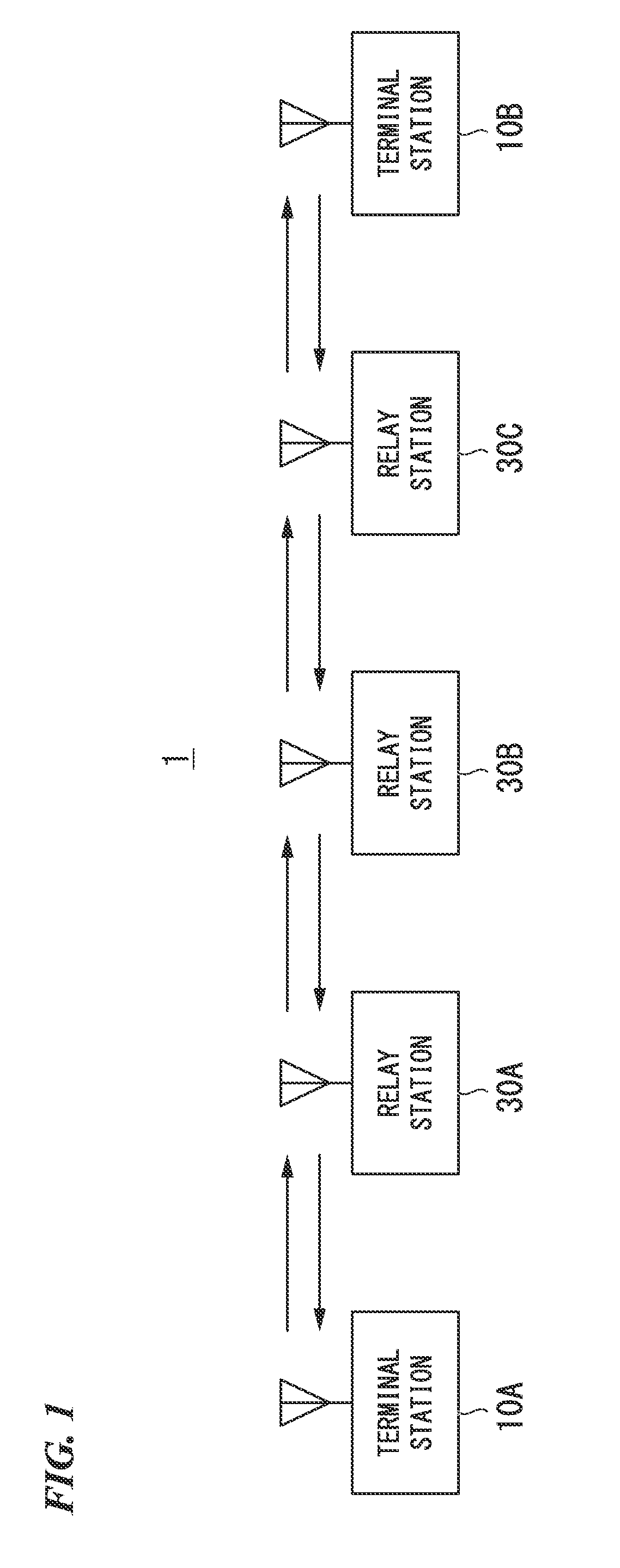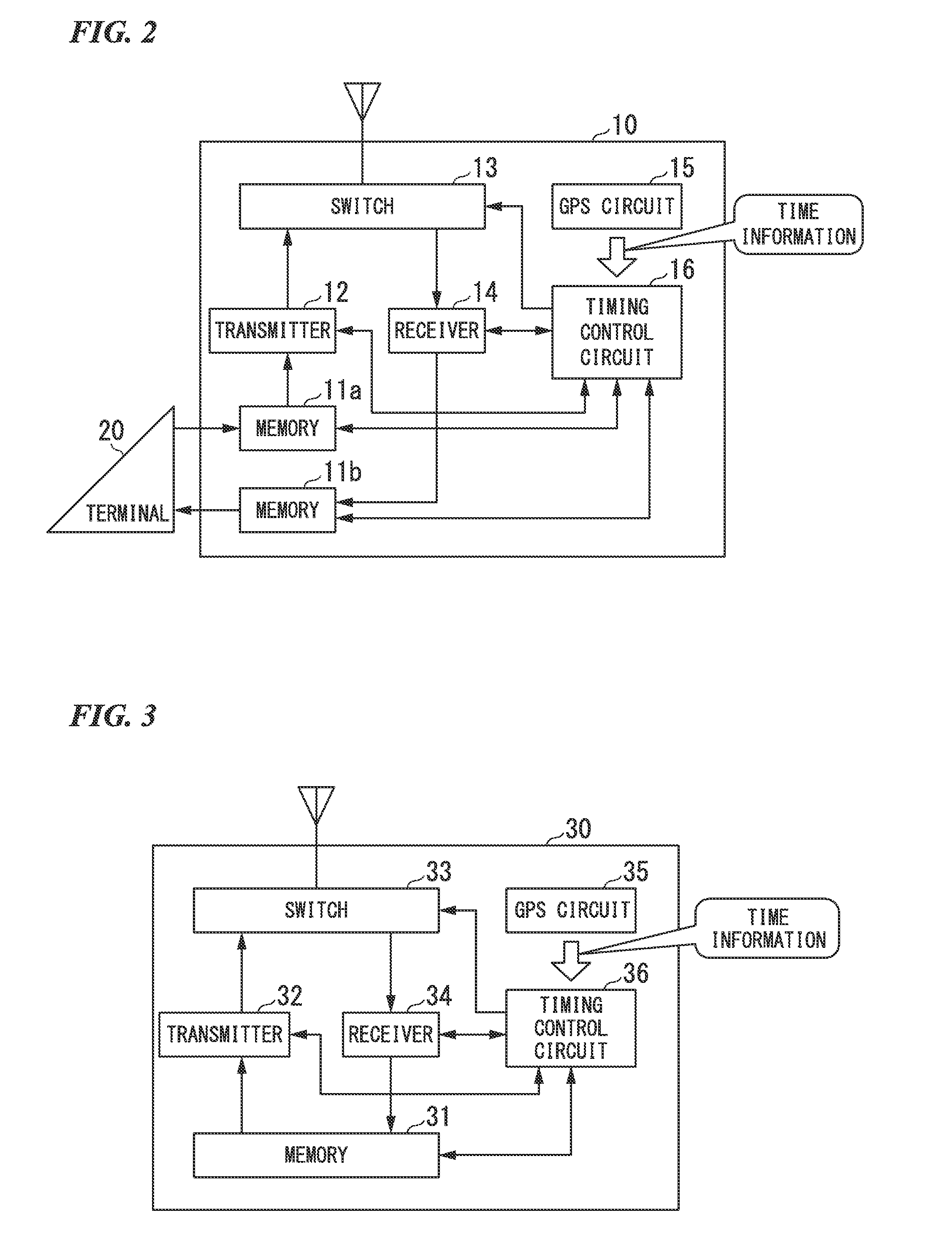Access control system, access control method, relay station apparatus, terminal station apparatus, transmitting side processing method, receiving side processing system, and receiving side processing method
a technology of access control and relay station, applied in the field of access control system, can solve problems such as the employment of network encoding technology, and achieve the effect of reducing the probability of packet collision and improving system throughpu
- Summary
- Abstract
- Description
- Claims
- Application Information
AI Technical Summary
Benefits of technology
Problems solved by technology
Method used
Image
Examples
first embodiment
[0052]FIG. 1 is a configuration diagram illustrating a configuration of a wireless relay system in accordance with the present embodiment.
[0053]A wireless relay system 1 illustrated in this drawing includes terminal stations 10A and 10B (also collectively referred to as terminal stations 10) and relay stations 30A, 30B, and 30C (also collectively referred to as relay stations 30).
[0054]The terminal stations 10A and 10B are wireless terminals of which communication is relayed instead of performing direct communication, and which communicate with each other. The terminal stations 10A and 10B perform a communication process, for example, when they are located in positions between which radio waves do not reach or when they are placed in a situation in which it is difficult to perform direct communication.
[0055]The relay stations 30 are arranged between the terminal stations 10A and 10B, and the relay stations 30 relay communication between the terminal stations 10A and 10B. In the wire...
second embodiment
[0097]The assignment of transmission rights in a wireless relay system in accordance with the present embodiment will be shown.
[0098]FIG. 7 is a timing chart illustrating the use of time slots of the wireless relay system in accordance with the present embodiment.
[0099]Relay stations 30 illustrated in this drawing are controlled by a wireless relay scheme in which an odd-numbered relay station 30 can only perform transmission at a time of an odd-numbered time slot, and an even-numbered relay station 30 can only perform transmission at a time of an even-numbered time slot. This scheme is applied to a model in which radio waves transmitted by a station itself interferes with those of an adjacent station, but the radio waves of the station itself do not interfere with those of a next adjacent station, thereby making it possible to avoid packet collisions between the relay stations 30 even when each relay station 30 transmits a packet in accordance with the random access scheme.
[0100]Th...
third embodiment
[0104]The assignment of transmission rights in a wireless relay system in accordance with the present embodiment will be shown.
[0105]FIG. 8 is a timing chart illustrating the use of time slots of the wireless relay system in accordance with the present embodiment.
[0106]Relay stations 30 illustrated in this drawing are controlled by a wireless relay scheme in which an even-numbered relay station 30 can only perform transmission at a time of an odd-numbered time slot, and an odd-numbered relay station 30 can only perform transmission at a time of an even-numbered time slot. This scheme is applied to a model in which radio waves transmitted by a station itself interfere with those of an adjacent station, but the radio waves of the station itself do not interference with those of a next adjacent station, thereby making it possible to avoid packet collisions between the relay stations 30 even when each relay station 30 transmits a packet in accordance with the random access scheme.
[0107]...
PUM
 Login to View More
Login to View More Abstract
Description
Claims
Application Information
 Login to View More
Login to View More - R&D
- Intellectual Property
- Life Sciences
- Materials
- Tech Scout
- Unparalleled Data Quality
- Higher Quality Content
- 60% Fewer Hallucinations
Browse by: Latest US Patents, China's latest patents, Technical Efficacy Thesaurus, Application Domain, Technology Topic, Popular Technical Reports.
© 2025 PatSnap. All rights reserved.Legal|Privacy policy|Modern Slavery Act Transparency Statement|Sitemap|About US| Contact US: help@patsnap.com



